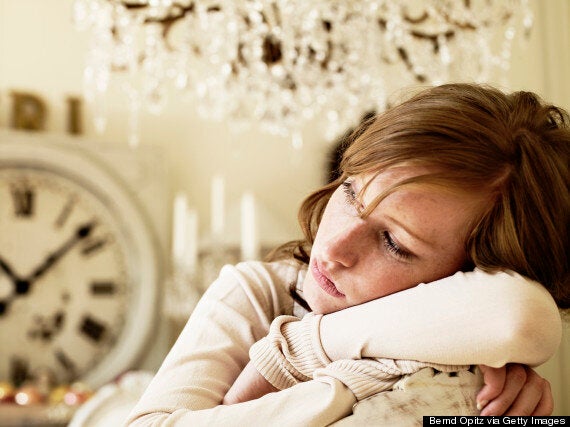“People often try to keep self-harm a secret because of shame or fear of discovery,” says the NHS website, but a growing occurrence is of young people posting images of their cuts online.
Self-harm and social media are in the media spotlight at the moment because of the tragic suicide of teenager Tallulah Wilson, who (it was revealed during the inquest) had had posted self-harm images on Tumblr.
Her mother, searching for reasons as to why Tallulah killed herself, said her daughter's addiction to the internet fuelled her death.

Tallulah Wilson, 15, was found dead on the tracks at St Pancras
Since then, discussions centred on whether social media sites, like Tumblr, should be more responsible in monitoring these types of images and whether or not the internet did indeed play a role in Tallulah’s death.
After one of our photo editors highlighted innovative ways users can navigate around social media policing, we were motivated to find out more. For example on social media sites such as Instagram, users replace blocked hashtags (such as #self-harm) with alternatives (such as #blood) - the latter serves up some pretty upsetting images of bloodied wrists and forearms.
When we spoke to an Instagram spokesperson to ask them what – if indeed any – moderation takes place, they said: “While Instagram is a place where people can share their lives with others through photographs, any account found encouraging or urging users to embrace anorexia, bulimia, or other eating disorders; or to cut, harm themselves, or commit suicide will result in a disabled account without warning.
"We believe that communication regarding these behaviors in order to create awareness, come together for support and to facilitate recovery is important, but that Instagram is not the place for active promotion or glorification of self-harm.”
Sheri Jacobson Collins, a psychotherapist at Harley Therapy, responded to the stance by saying: “I would avoid chastising those who post these images as in many cases self-harm is not about seeking attention, but a way of dealing with distress. We need to direct our focus on offering support rather than judging."
She added: “I'd like to think that when such images are posted, companies like Instagram didn't just send a message saying their account was closed but sent them a communication with options for help such as the Samaritans, Saneline, their GP and emergency services.”
However top photosharing social media sites - Instagram, Imgur and Tumblr - host millions of images, so regulation is bound to be difficult.
But the problem at the other end of the scale, with the heavy-handed moderation of sites like Facebook, is a set of sanctions so prudish and narrow-minded that they often prevent images of gay people and breast cancer survivors from being posted.

In 2011, a study by The Lancet revealed that 1 in 12 teenagers self-harm, but most will stop by early adulthood.
The burning question, however, is whether self-harm images encourage young people to cut themselves.
“It depends on the individual,” says Sheri, “For some, it could be a turn-off, as it could hold a mirror up to the behaviour they are engaging in and help foster a willingness to seek help.
“However for many it is unlikely to act as a deterrent since self-harm is purposeful - it is commonly used as a way to deal with negative feelings (depression, anger or guilt for example), which may be ongoing and entrenched.”
Sara McCorquodale, editor of MyDaily.co.uk, spoke about her experiences as a former self-harmer.
She says: “When I was self-harming, social media didn't exist and I can't imagine wanting to tell anyone. What I can say is, self-harming is quite a big secret to carry around and as it gets worse, hiding it - and telling no one - is a burden.
“You assume friends and family wouldn't understand because you know it's quite a strange thing to do. I suppose knowing there are a community of people who can empathise could be comforting but even then I'm perplexed about the pictures.”
Sara believes, like Sheri, that a person who is self-harming is likely to do so anyway.
“In my experience, the thing that perpetuated self-harming was that it becomes quite addictive and compulsive. More than anything, that's why I found it hard to stop - it's a very instant release. I think blocking sharing pictures of self-harming on social media wouldn't solve the problem it would just hide it. I very much doubt people start this type of behaviour as a result of Instagram /Tumblr,” says Sara.
Tumblr, the site used by Tallulah, issued this message after the teenager's death: "Tumblr has policies to address the most harmful of this content, and we have systems in place to direct users to appropriate resources for getting whatever help they may need.
"We are committed to continually improving our ability to act on self-harm content, and also to keeping Tumblr a positive, supportive environment for those individuals dealing with issues of depression and self-harm."
Warning signs that a family member or friend is cutting or self-injuring
- Unexplained wounds or scars from cuts, bruises, or burns, usually on the wrists, arms, thighs, or chest.
- Blood stains on clothing, towels, or bedding; blood-soaked tissues.
- Sharp objects or cutting instruments, such as razors, knives, needles, glass shards, or bottle caps, in the person’s belongings.
- Frequent “accidents.” Someone who self-harms may claim to be clumsy or have many mishaps, in order to explain away injuries.
- Covering up. A person who self-injures may insist on wearing long sleeves or long pants, even in hot weather.
- Needing to be alone for long periods of time, especially in the bedroom or bathroom.
- Isolation and irritability.
But Paul Farmer, chief executive of mental health charity Mind, says that a stronger stance needs to be taken against social media sites. “Websites that promote self-harm and suicide can be incredibly damaging and social media platforms need to look hard at their policies and practice to make sure they are not accommodating content that could encourage users to harm themselves.”
Self-harm is a way of dealing with overwhelming situations or negative feelings, and trying to get control at a time when everything in that person’s life may be volatile. Certainly for Sara, her self-harming started because her best friend was dying from cancer and she was leaving her childhood home to move in with her step-father.
But while the person self-harming may be doing so to regain control in their life, it can also be quite isolating. Perhaps this may be a reason why some choose to share such images online.
Sheri says: “There may be a wish to connect and soothe loneliness. Often, especially with teenagers, it's about feeling that nobody out there understands or cares, so it could be a move to feel they are not entirely alone.
“Plus over the internet, there is still a sense that you maintain your privacy because of the virtual nature of social connections. In other words, people posting these images on the internet might ironically still feel a sense of privacy.”
Samaritans has a comprehensive feature on their stance around self-harm practices and the internet, as well as how it relates to suicide. It is already doing great work in the field – it’s currently a partner in research to find out the impact of online interactions pertaining to suicide.
They also believe that search engines should have responsibility, so they now work with Google so that when people search for certain keywords, the contact details for Samaritans pop up.
Instagram also employs a warning message, so certain hashtags trigger warning messages that link to external help resources.
“It's possible that some individuals who are self-harming might get further ideas,” says Sheri. “If a person has a personality that is subject to extremes, seeing such images might be more damaging in leading them to ‘compete’. But I would argue that it is not likely to cause individuals to self harm unless there was an existing tendency to do so.”
The solution – for now – seems to be to provide help to vulnerable people self-harming where possible. Also, to show them that there is hope that they can stop.
Sara says: “I just didn't know how to regulate or handle some quite extreme emotions and panicked quite a lot about most things.
“The thing that changed everything for me was joining the gym - exercise was brilliant for just mellowing out and clearing my head. I felt great afterwards and it made me look at my body very differently. I stopped self-harming when I was 16 thanks to this and haven't since.”
HELP: If you need advice on coping with suicidal thoughts, self harm or how to support loved ones, visit mind.org.uk or call our Infoline on 0300 123 3393. Alternatively you can visit the National Self Harm Network here.
For help on suicide prevention or for advice and support, visit the Samaritans website or call 08457 90 90 90.